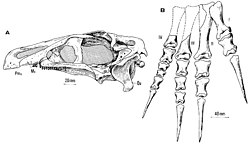Erlikosaurus
|
Erlikosaurus Temporal range: Late Cretaceous, 90 Ma |
|
|---|---|
 |
|
| Skull and foot of the holotype specimen | |
| Scientific classification | |
| Kingdom: | Animalia |
| Phylum: | Chordata |
| Class: | Reptilia |
| Clade: | Dinosauria |
| Order: | Saurischia |
| Suborder: | Theropoda |
| Family: | †Therizinosauridae |
| Genus: |
†Erlikosaurus Perle, 1980 |
| Species: | †E. andrewsi |
| Binomial name | |
|
Erlikosaurus andrewsi Perle, 1980 |
|
Erlikosaurus is a genus of herbivorous theropod dinosaur from the late Cretaceous Period, belonging to the Therizinosauridae. Its fossils, a skull and some post-cranial fragments, were found in the Bayan Shireh Formation of Mongolia, dating to around 90 million years ago.
Erlikosaurus were therizinosaurs, a strange group of theropods that ate plants instead of meat, and that had backward-facing pubises like ornithischians. Also like ornithischians, their jaws were tipped by a broad rounded bony beak useful for cropping off plants. Behind the beak, separated by an hiatus, there were per side twenty-three small straight coarsely serrated teeth in the maxilla. The dentary of the lower jaw had more teeth: thirty-one for a total of one hundred eight. The bony nostrils of Erlikosaurus were very large and elongated. The braincase was swollen at the back by pneumatised bone. Scientists now know some therizinosaurs were feathered, so it is likely that Erlikosaurus were as well. Erlikosaurus had exceptionally long slender claws on their feet, with a bone core of up to ten centimetres, the purpose of which is unclear; G.S. Paul surmised they were used for self-defence.
As the genus is only known from very fragmentary material, it has been problematic to determine the size of Erlikosaurus, especially as most of the vertebral column of the holotype is missing. The skull length is twenty-five centimetres; the humerus is thirty centimetres long. It has been estimated to attain an adult body length of six meters (twenty feet). Erlikosaurus may have been more lightly built than close relative Segnosaurus. Other estimates are lower: in 2010 Gregory S. Paul gave a length of 4.5 metres and a weight of half a tonne.
The remains of Erlikosaurus were discovered in 1972 at Bayshin Tsav, during a Soviet-Mongolian expedition in Ömnögovi Province. The type species, Erlikosaurus andrewsi, was named and described by Altangerel Perle in 1980, in an article co-authored with Rinchen Barsbold, who however, is not indicated as the name-giver of this particular species. Its generic name was taken from that of the demon king Erlik from Turko-Mongolian mythology and the specific name of the American paleontologist Roy Chapman Andrews. Confusingly, in 1981 Perle again named the species as if it were new, this time spelling the generic name as a Latinised "Erlicosaurus". It is today generally considered that the original name, Erlikosaurus, is valid.
...
Wikipedia
